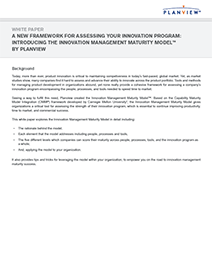Introducing the Innovation Management Maturity Model™
Brought to you by Planview®
The Innovation Management Maturity Model™ is a framework for assessing a company’s innovation program encompassing the people, processes and tools needed to speed time to market.
See how you rank against over 700 product development professionals across the globe who evaluated their innovation management maturity using this model in the Fourth Product Portfolio Management Benchmark Study (conducted by Appleseed Partners and Open Sky Research and commissioned by Planview).
- Level 5
- Executive leadership fosters innovation
- “Center for Process Excellence and Innovation” is well-established and reports to executive team
- Decision making collaborative and efficient
- Everyone throughout the commercialization process understands role
- Project managers and scrum masters lead innovation and development teams leveraging best practices
- Level 4
- Early formation of a “Center for Process Excellence”
- Process managers and gatekeepers have clear direction, metrics, and ownership
- Formalized portfolio manager positions at business unit and enterprise levels
- Multiple strong champions for innovation
- Project teams consist of cross-functional team members
- Start of open innovation, co-development, and the use of external innovation consultants
- Level 3
- Established roles in the commercialization process: process managers, project managers, resource managers, and gate-keepers
- Beginning to champion innovation and portfolio management
- Level 2
- Individual leaders own day-to-day processes and are responsible for developing and delivering the product roadmap
- Project managers not consistently following industry best practices
- Cross-functional project teams not optimized for efficiency
- Innovation leaders starting to emerge and introduce change
- Level 1
- No cross-functional organization focused on innovation
- Decision making about the product portfolio by executive leadership only, often with less than optimal data
- Informal project leadership; resources assigned verbally
- Execution and product launches happen slow and steady
- Unclear connection/hand-offs throughout commercialization process
- Level 5
- Fully automated and standardized processes that are easily adaptable
- Portfolio metrics evolved to include competitive and environmental impact scores
- Projects killed early and often during portfolio reviews
- Voice of the customer captured on an ongoing basis
- Continuous learning loop well established
- Process covers idea to launch, and through to end of life
- Level 4
- Fully implemented gated process across multiple teams with some automation
- Gaining courage killing underperforming projects
- Portfolio metrics expanded to include resource capacity and strategic alignment
- Capturing voice of the customer with caution
- Governance process becoming efficient and streamlined
- Level 3
- Documented and validated gated commercialization process in place based on best practice
- Regular portfolio reviews and post-mortems conducted
- Voice of the customer becoming more formalized
- Governance workflow not yet consistently repeatable
- A few projects being killed, but later than optimal
- Level 2
- Informal process for innovation and idea flow; templates in use
- Portfolio reviews are more project status updates
- Metrics for evaluating innovation are purely financial
- Early realization of silo inefficiency and value of gated processes with cross-functional participation
- Level 1
- Processes are departmentally focused and not documented
- No formal gated process or templates for product development; projects rarely killed
- Limited visibility into actuals, forecasts, post-mortem assessment, or roadmaps; no portfolio reviews
- Processes surrounding ideation, roadmap development, and portfolio reviews do not exist
- Level 5
- Highly functioning PPM system integrated to other enterprise tools
- Ideation collected for collaboration
- Product roadmap tied to project execution and corporate strategy via PPM
- Entire product catalog of in-market products, including the Product P&L, managed via PPM
- Self-service configurable reports and metrics delivered across the organization
- Level 4
- Product Portfolio Management (PPM) system in place automating the commercialization process
- Resource capacity planning, roadmapping, and financial forecasting being piloted within PPM
- Dedicated tool for capturing voice of the customer
- Executive and project-level reporting and analytics are available and modifiable
- Level 3
- Manual portfolio management using spreadsheets
- Desktop project management tools in use
- Soon to automate the commercialization process
- Ideation centralized but not using a purpose built tool
- Standard library of reports exist; created manually by IT
- Level 2
- Moving to shared spreadsheets in central location
- Ideation matured to being captured and prioritized
- Projects managed via desktop tool but not shared
- Roadmap communicated via static spreadsheet; rarely updated
- Reporting and analytics starting to be shared and built manually
- Level 1
- Manual, decentralized, un-integrated spreadsheets and basic project tracking tools
- Only one or two centralized applications are in use
- New ideas for innovation captured informally
- Reporting inconsistent and roadmapping rare, executed via local desktop tools
- Level 5
- We have operationalized innovation with well-defined processes and formalized tools. Innovation is embedded in our company culture across all functions. We have a well-balanced portfolio with incremental and breakthrough innovation that yields positive revenue growth. We have the ability to launch products as planned and with confidence, meeting time to market targets.
- Level 4
- Our innovation strategy is emerging and we are working to tie it to our strategic objectives for growth. The lack of connection between project execution and product/corporate strategy results in an unbalanced portfolio making it difficult to quickly respond to market changes. There is a growing innovation pipeline, we are getting to market faster, and we are achieving many of our performance metrics. Innovation efforts have visibility, but it’s not yet embedded in our culture.
- Level 3
- We are becoming more proactive in seeking innovation as a key part of our product portfolio. Our innovation strategy and metrics are not clearly defined and communicated, and as a result we occasionally miss market windows and margin targets. Our leadership team is actively investing in tools, processes, and capabilities to operationalize innovation.
- Level 2
- Delivery of products, mostly line extensions and solid enhancements to existing products, is growing in consistency, but we typically operate in reaction mode. Our leadership is starting to understand the need for investing in innovation. Our innovation strategy centers on safe bets with occasional calculated risks, resulting in unpredictable outcomes.
- Level 1
- We are in a mature market where revenue is primarily driven from existing products and minor line extensions. There is some innovation in process and operations throughout the organization, but it is not required for company success. Our strategy is focused on conservative investments resulting in gradual and predictable growth.

